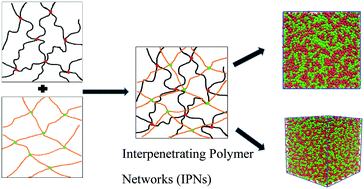当前位置:
X-MOL 学术
›
Soft Matter
›
论文详情
Our official English website, www.x-mol.net, welcomes your
feedback! (Note: you will need to create a separate account there.)
Tailoring the mechanical properties by molecular integration of flexible and stiff polymer networks
Soft Matter ( IF 2.9 ) Pub Date : 2018-02-17 00:00:00 , DOI: 10.1039/c7sm02282d Haixiao Wan 1, 2, 3 , Jianxiang Shen 4, 5, 6, 7 , Naishen Gao 1, 2, 3 , Jun Liu 1, 2, 2, 3, 8 , Yangyang Gao 1, 2, 3 , Liqun Zhang 1, 2, 2, 3, 8
Soft Matter ( IF 2.9 ) Pub Date : 2018-02-17 00:00:00 , DOI: 10.1039/c7sm02282d Haixiao Wan 1, 2, 3 , Jianxiang Shen 4, 5, 6, 7 , Naishen Gao 1, 2, 3 , Jun Liu 1, 2, 2, 3, 8 , Yangyang Gao 1, 2, 3 , Liqun Zhang 1, 2, 2, 3, 8
Affiliation

|
Designing a multiple-network structure at the molecular level to tailor the mechanical properties of polymeric materials is of great scientific and technological importance. Through the coarse-grained molecular dynamics simulation, we successfully construct an interpenetrating polymer network (IPN) composed of a flexible polymer network and a stiff polymer network. First, we find that there is an optimal chain stiffness for a single network (SN) to achieve the best stress–strain behavior. Then we turn to study the mechanical behaviors of IPNs. The result shows that the stress–strain behaviors of the IPNs appreciably exceed the sum of that of the corresponding single flexible and stiff network, which highlights the advantage of the IPN structure. By systematically varying the stiffness of the stiff polymer network of the IPNs, optimal stiffness also exists to achieve the best performance. We attribute this to a much larger contribution of the non-bonded interaction energy. Last, the effect of the component concentration ratio is probed. With the increase of the concentration of the flexible network, the stress–strain behavior of the IPNs is gradually enhanced, while an optimized concentration (around 60% molar ration) of the stiff network occurs, which could result from the dominant role of the enthalpy rather than the entropy. In general, our work is expected to provide some guidelines to better tailor the mechanical properties of the IPNs made of a flexible network and a stiff network, by manipulating the stiffness of the stiff polymer network and the component concentration ratio.
中文翻译:

通过柔性和刚性聚合物网络的分子整合来调整机械性能
在分子水平上设计多网络结构以调整聚合物材料的机械性能具有重大的科学技术意义。通过粗粒分子动力学模拟,我们成功构建了由柔性聚合物网络和刚性聚合物网络组成的互穿聚合物网络(IPN)。首先,我们发现单个网络(SN)具有最佳的链刚度,可以实现最佳的应力应变行为。然后我们转向研究IPN的力学行为。结果表明,IPN的应力-应变行为明显超过了相应的单个柔性和刚性网络的总和,这突出了IPN结构的优势。通过系统地改变IPN的刚性聚合物网络的刚度,还存在最佳刚度以实现最佳性能。我们将其归因于非键相互作用能的更大贡献。最后,探讨了组分浓度比的影响。随着柔性网络浓度的增加,IPN的应力-应变行为逐渐增强,同时出现了刚性网络的最佳浓度(摩尔比约为60%),这可能是由于焓的主导作用所致。而不是熵。总的来说,我们的工作有望提供一些指导,以通过控制刚性聚合物网络的刚度和组分浓度比,更好地定制由柔性网络和刚性网络制成的IPN的机械性能。我们将其归因于非键相互作用能的更大贡献。最后,探讨了组分浓度比的影响。随着柔性网络浓度的增加,IPN的应力-应变行为逐渐增强,同时出现了刚性网络的最佳浓度(摩尔比约为60%),这可能是由于焓的主导作用所致。而不是熵。总的来说,我们的工作有望提供一些指导,以通过控制刚性聚合物网络的刚度和组分浓度比,更好地定制由柔性网络和刚性网络制成的IPN的机械性能。我们将其归因于非键相互作用能的更大贡献。最后,探讨了组分浓度比的影响。随着柔性网络浓度的增加,IPN的应力-应变行为逐渐增强,而刚性网络的最佳浓度(摩尔比为60%左右)出现了,这可能是由于焓的主导作用所致。而不是熵。总的来说,我们的工作有望提供一些指导,以通过控制刚性聚合物网络的刚度和组分浓度比,更好地定制由柔性网络和刚性网络制成的IPN的机械性能。随着柔性网络浓度的增加,IPN的应力-应变行为逐渐增强,同时出现了刚性网络的最佳浓度(摩尔比约为60%),这可能是由于焓的主导作用所致。而不是熵。总的来说,我们的工作有望提供一些指导,以通过控制刚性聚合物网络的刚度和组分浓度比,更好地定制由柔性网络和刚性网络制成的IPN的机械性能。随着柔性网络浓度的增加,IPN的应力-应变行为逐渐增强,同时出现了刚性网络的最佳浓度(摩尔比约为60%),这可能是由于焓的主导作用所致。而不是熵。总的来说,我们的工作有望提供一些指导,以通过控制刚性聚合物网络的刚度和组分浓度比,更好地定制由柔性网络和刚性网络制成的IPN的机械性能。
更新日期:2018-02-17
中文翻译:

通过柔性和刚性聚合物网络的分子整合来调整机械性能
在分子水平上设计多网络结构以调整聚合物材料的机械性能具有重大的科学技术意义。通过粗粒分子动力学模拟,我们成功构建了由柔性聚合物网络和刚性聚合物网络组成的互穿聚合物网络(IPN)。首先,我们发现单个网络(SN)具有最佳的链刚度,可以实现最佳的应力应变行为。然后我们转向研究IPN的力学行为。结果表明,IPN的应力-应变行为明显超过了相应的单个柔性和刚性网络的总和,这突出了IPN结构的优势。通过系统地改变IPN的刚性聚合物网络的刚度,还存在最佳刚度以实现最佳性能。我们将其归因于非键相互作用能的更大贡献。最后,探讨了组分浓度比的影响。随着柔性网络浓度的增加,IPN的应力-应变行为逐渐增强,同时出现了刚性网络的最佳浓度(摩尔比约为60%),这可能是由于焓的主导作用所致。而不是熵。总的来说,我们的工作有望提供一些指导,以通过控制刚性聚合物网络的刚度和组分浓度比,更好地定制由柔性网络和刚性网络制成的IPN的机械性能。我们将其归因于非键相互作用能的更大贡献。最后,探讨了组分浓度比的影响。随着柔性网络浓度的增加,IPN的应力-应变行为逐渐增强,同时出现了刚性网络的最佳浓度(摩尔比约为60%),这可能是由于焓的主导作用所致。而不是熵。总的来说,我们的工作有望提供一些指导,以通过控制刚性聚合物网络的刚度和组分浓度比,更好地定制由柔性网络和刚性网络制成的IPN的机械性能。我们将其归因于非键相互作用能的更大贡献。最后,探讨了组分浓度比的影响。随着柔性网络浓度的增加,IPN的应力-应变行为逐渐增强,而刚性网络的最佳浓度(摩尔比为60%左右)出现了,这可能是由于焓的主导作用所致。而不是熵。总的来说,我们的工作有望提供一些指导,以通过控制刚性聚合物网络的刚度和组分浓度比,更好地定制由柔性网络和刚性网络制成的IPN的机械性能。随着柔性网络浓度的增加,IPN的应力-应变行为逐渐增强,同时出现了刚性网络的最佳浓度(摩尔比约为60%),这可能是由于焓的主导作用所致。而不是熵。总的来说,我们的工作有望提供一些指导,以通过控制刚性聚合物网络的刚度和组分浓度比,更好地定制由柔性网络和刚性网络制成的IPN的机械性能。随着柔性网络浓度的增加,IPN的应力-应变行为逐渐增强,同时出现了刚性网络的最佳浓度(摩尔比约为60%),这可能是由于焓的主导作用所致。而不是熵。总的来说,我们的工作有望提供一些指导,以通过控制刚性聚合物网络的刚度和组分浓度比,更好地定制由柔性网络和刚性网络制成的IPN的机械性能。











































 京公网安备 11010802027423号
京公网安备 11010802027423号